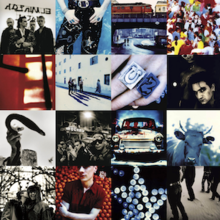Achtung Baby
| Achtung Baby | ||||
|---|---|---|---|---|
 |
||||
| Studio album by U2 | ||||
| Released | 18 November 1991 | |||
| Recorded | October 1990 – September 1991 | |||
| Studio |
|
|||
| Genre | Alternative rock | |||
| Length | 55:27 | |||
| Label | Island | |||
| Producer | Daniel Lanois, Brian Eno | |||
| U2 chronology | ||||
|
||||
| Singles from Achtung Baby | ||||
|
||||
| Professional ratings | |
|---|---|
| Aggregate scores | |
| Source | Rating |
| Metacritic | 93/100 (2011) |
| Review scores | |
| Source | Rating |
| AllMusic | |
| Chicago Tribune | |
| Entertainment Weekly | A |
| Hot Press | 10/12 |
| Los Angeles Times | |
| The New Zealand Herald | |
| Orlando Sentinel | |
| Q | |
| Rolling Stone | |
| Spin | |
Achtung Baby (pronunciation: /ˈɑːktuːŋ ˈbeɪbiː/) is the seventh studio album by Irish rock band U2. It was produced by Daniel Lanois and Brian Eno, and was released on 18 November 1991 on Island Records. Stung by criticism of their 1988 release, Rattle and Hum, U2 shifted their musical direction to incorporate influences from alternative rock, industrial music, and electronic dance music into their sound. Thematically, Achtung Baby is darker, more introspective, and at times more flippant than their previous work. The album and the subsequent multimedia-intensive Zoo TV Tour were central to the group's 1990s reinvention, by which they abandoned their earnest public image for a more lighthearted and self-deprecating one.
Seeking inspiration from German reunification, U2 began recording Achtung Baby at Berlin's Hansa Studios in October 1990. The sessions were fraught with conflict, as the band argued over their musical direction and the quality of their material. After tensions and slow progress nearly prompted the group to disband, they made a breakthrough with the improvised writing of the song "One". Morale and productivity improved during subsequent recording sessions in Dublin, where the album was completed in 1991. To confound the public's expectations of the band and their music, U2 chose the record's facetious title and colourful multi-image sleeve.
...
Wikipedia
